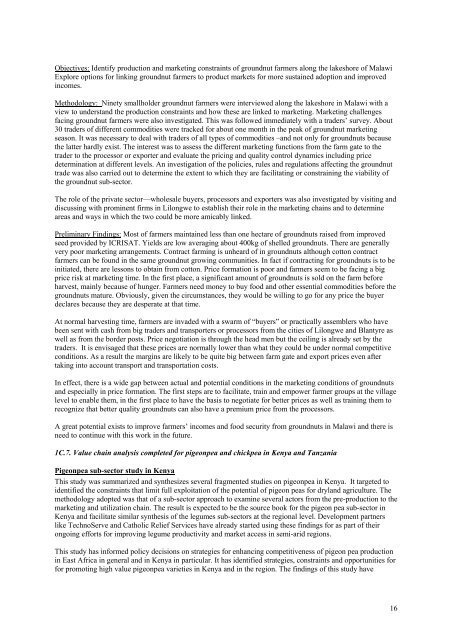ICRISAT Archival Report 2006 - The seedlings of success in the ...
ICRISAT Archival Report 2006 - The seedlings of success in the ...
ICRISAT Archival Report 2006 - The seedlings of success in the ...
Create successful ePaper yourself
Turn your PDF publications into a flip-book with our unique Google optimized e-Paper software.
Objectives: Identify production and market<strong>in</strong>g constra<strong>in</strong>ts <strong>of</strong> groundnut farmers along <strong>the</strong> lakeshore <strong>of</strong> Malawi<br />
Explore options for l<strong>in</strong>k<strong>in</strong>g groundnut farmers to product markets for more susta<strong>in</strong>ed adoption and improved<br />
<strong>in</strong>comes.<br />
Methodology: N<strong>in</strong>ety smallholder groundnut farmers were <strong>in</strong>terviewed along <strong>the</strong> lakeshore <strong>in</strong> Malawi with a<br />
view to understand <strong>the</strong> production constra<strong>in</strong>ts and how <strong>the</strong>se are l<strong>in</strong>ked to market<strong>in</strong>g. Market<strong>in</strong>g challenges<br />
fac<strong>in</strong>g groundnut farmers were also <strong>in</strong>vestigated. This was followed immediately with a traders’ survey. About<br />
30 traders <strong>of</strong> different commodities were tracked for about one month <strong>in</strong> <strong>the</strong> peak <strong>of</strong> groundnut market<strong>in</strong>g<br />
season. It was necessary to deal with traders <strong>of</strong> all types <strong>of</strong> commodities –and not only for groundnuts because<br />
<strong>the</strong> latter hardly exist. <strong>The</strong> <strong>in</strong>terest was to assess <strong>the</strong> different market<strong>in</strong>g functions from <strong>the</strong> farm gate to <strong>the</strong><br />
trader to <strong>the</strong> processor or exporter and evaluate <strong>the</strong> pric<strong>in</strong>g and quality control dynamics <strong>in</strong>clud<strong>in</strong>g price<br />
determ<strong>in</strong>ation at different levels. An <strong>in</strong>vestigation <strong>of</strong> <strong>the</strong> policies, rules and regulations affect<strong>in</strong>g <strong>the</strong> groundnut<br />
trade was also carried out to determ<strong>in</strong>e <strong>the</strong> extent to which <strong>the</strong>y are facilitat<strong>in</strong>g or constra<strong>in</strong><strong>in</strong>g <strong>the</strong> viability <strong>of</strong><br />
<strong>the</strong> groundnut sub-sector.<br />
<strong>The</strong> role <strong>of</strong> <strong>the</strong> private sector—wholesale buyers, processors and exporters was also <strong>in</strong>vestigated by visit<strong>in</strong>g and<br />
discuss<strong>in</strong>g with prom<strong>in</strong>ent firms <strong>in</strong> Lilongwe to establish <strong>the</strong>ir role <strong>in</strong> <strong>the</strong> market<strong>in</strong>g cha<strong>in</strong>s and to determ<strong>in</strong>e<br />
areas and ways <strong>in</strong> which <strong>the</strong> two could be more amicably l<strong>in</strong>ked.<br />
Prelim<strong>in</strong>ary F<strong>in</strong>d<strong>in</strong>gs: Most <strong>of</strong> farmers ma<strong>in</strong>ta<strong>in</strong>ed less than one hectare <strong>of</strong> groundnuts raised from improved<br />
seed provided by <strong>ICRISAT</strong>. Yields are low averag<strong>in</strong>g about 400kg <strong>of</strong> shelled groundnuts. <strong>The</strong>re are generally<br />
very poor market<strong>in</strong>g arrangements. Contract farm<strong>in</strong>g is unheard <strong>of</strong> <strong>in</strong> groundnuts although cotton contract<br />
farmers can be found <strong>in</strong> <strong>the</strong> same groundnut grow<strong>in</strong>g communities. In fact if contract<strong>in</strong>g for groundnuts is to be<br />
<strong>in</strong>itiated, <strong>the</strong>re are lessons to obta<strong>in</strong> from cotton. Price formation is poor and farmers seem to be fac<strong>in</strong>g a big<br />
price risk at market<strong>in</strong>g time. In <strong>the</strong> first place, a significant amount <strong>of</strong> groundnuts is sold on <strong>the</strong> farm before<br />
harvest, ma<strong>in</strong>ly because <strong>of</strong> hunger. Farmers need money to buy food and o<strong>the</strong>r essential commodities before <strong>the</strong><br />
groundnuts mature. Obviously, given <strong>the</strong> circumstances, <strong>the</strong>y would be will<strong>in</strong>g to go for any price <strong>the</strong> buyer<br />
declares because <strong>the</strong>y are desperate at that time.<br />
At normal harvest<strong>in</strong>g time, farmers are <strong>in</strong>vaded with a swarm <strong>of</strong> “buyers” or practically assemblers who have<br />
been sent with cash from big traders and transporters or processors from <strong>the</strong> cities <strong>of</strong> Lilongwe and Blantyre as<br />
well as from <strong>the</strong> border posts. Price negotiation is through <strong>the</strong> head men but <strong>the</strong> ceil<strong>in</strong>g is already set by <strong>the</strong><br />
traders. It is envisaged that <strong>the</strong>se prices are normally lower than what <strong>the</strong>y could be under normal competitive<br />
conditions. As a result <strong>the</strong> marg<strong>in</strong>s are likely to be quite big between farm gate and export prices even after<br />
tak<strong>in</strong>g <strong>in</strong>to account transport and transportation costs.<br />
In effect, <strong>the</strong>re is a wide gap between actual and potential conditions <strong>in</strong> <strong>the</strong> market<strong>in</strong>g conditions <strong>of</strong> groundnuts<br />
and especially <strong>in</strong> price formation. <strong>The</strong> first steps are to facilitate, tra<strong>in</strong> and empower farmer groups at <strong>the</strong> village<br />
level to enable <strong>the</strong>m, <strong>in</strong> <strong>the</strong> first place to have <strong>the</strong> basis to negotiate for better prices as well as tra<strong>in</strong><strong>in</strong>g <strong>the</strong>m to<br />
recognize that better quality groundnuts can also have a premium price from <strong>the</strong> processors.<br />
A great potential exists to improve farmers’ <strong>in</strong>comes and food security from groundnuts <strong>in</strong> Malawi and <strong>the</strong>re is<br />
need to cont<strong>in</strong>ue with this work <strong>in</strong> <strong>the</strong> future.<br />
1C.7. Value cha<strong>in</strong> analysis completed for pigeonpea and chickpea <strong>in</strong> Kenya and Tanzania<br />
Pigeonpea sub-sector study <strong>in</strong> Kenya<br />
This study was summarized and syn<strong>the</strong>sizes several fragmented studies on pigeonpea <strong>in</strong> Kenya. It targeted to<br />
identified <strong>the</strong> constra<strong>in</strong>ts that limit full exploitation <strong>of</strong> <strong>the</strong> potential <strong>of</strong> pigeon peas for dryland agriculture. <strong>The</strong><br />
methodology adopted was that <strong>of</strong> a sub-sector approach to exam<strong>in</strong>e several actors from <strong>the</strong> pre-production to <strong>the</strong><br />
market<strong>in</strong>g and utilization cha<strong>in</strong>. <strong>The</strong> result is expected to be <strong>the</strong> source book for <strong>the</strong> pigeon pea sub-sector <strong>in</strong><br />
Kenya and facilitate similar syn<strong>the</strong>sis <strong>of</strong> <strong>the</strong> legumes sub-sectors at <strong>the</strong> regional level. Development partners<br />
like TechnoServe and Catholic Relief Services have already started us<strong>in</strong>g <strong>the</strong>se f<strong>in</strong>d<strong>in</strong>gs for as part <strong>of</strong> <strong>the</strong>ir<br />
ongo<strong>in</strong>g efforts for improv<strong>in</strong>g legume productivity and market access <strong>in</strong> semi-arid regions.<br />
This study has <strong>in</strong>formed policy decisions on strategies for enhanc<strong>in</strong>g competitiveness <strong>of</strong> pigeon pea production<br />
<strong>in</strong> East Africa <strong>in</strong> general and <strong>in</strong> Kenya <strong>in</strong> particular. It has identified strategies, constra<strong>in</strong>ts and opportunities for<br />
for promot<strong>in</strong>g high value pigeonpea varieties <strong>in</strong> Kenya and <strong>in</strong> <strong>the</strong> region. <strong>The</strong> f<strong>in</strong>d<strong>in</strong>gs <strong>of</strong> this study have<br />
16

















